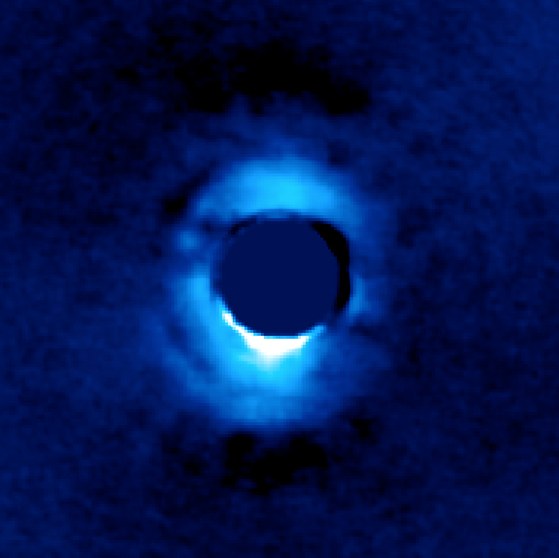The biggest difficulty facing astronomers looking for worlds orbiting distant stars is the obscuring glare of starlight that can completely hide the dimmer light bouncing off orbiting exoplanets. The glare can be millions of times brighter than the reflected light, requiring astronomers to devise ingenious techniques to reduce that glare. Oftentimes, "occulters" are used within instrumentation — basically tiny disks that physically block the intense starlight from view (a bit like holding your hand up to the sun to block the sun's glare), allowing features around the star to be detected.
Occulters, however, have their limitations. The biggest problem is that, though this method allows the detection of exoplanets orbiting far from their stars, too much glare still bleeds through, obscuring the signal of exoplanets orbiting near to their stars. Entire systems of planets can be blocked from view if their orbits are compact, particularly for more distant stars where planetary systems will appear smaller.
By manipulating the properties of light, however, a new device called a vortex coronagraph installed at the W.M. Keck Observatory in Hawaii has revealed the presence of a brown dwarf closely orbiting the star HIP 79124 (pictured top) and highlighted a planet-forming cloud of dust around the young star HD 141569. Neither objects would have been spotted if the astronomers used more conventional methods of direct imaging.
"The vortex coronagraph allows us to peer into the regions around stars where giant planets like Jupiter and Saturn supposedly form," said research scientist Dmitri Mawet, at NASA's Jet Propulsion Laboratory and Caltech in Pasadena. "Before now, we were only able to image gas giants that are born much farther out. With the vortex, we will be able to see planets orbiting as close to their stars as Jupiter is to our sun, or about two to three times closer than what was possible before."
The vortex coronagraph works by manipulating the starlight coming directly from the star. A filter with microscopic concentric rings act to direct the star's glare away from the instrument's optics. As light is electromagnetic waves, in the center of the coronagraph these waves are directed to cancel each other out (a physical mechanism known as destructive interference). This canceled light creates a dark region in the center, called an "optical singularity," effectively blocking the glare of the star. This method therefore allows the reflected light of worlds orbiting very close to their star to be resolved.
 |
| Appearing like a miniature CD, the vortex coronagraph mask is made out of synthetic diamond. A microscopic view of its concentric rings are shown to the right |
In the case of HIP 79124, a brown dwarf was discovered orbiting the star at a distance of 23 AU (astronomical units, where 1AU is the average distance at which the Earth orbits the sun). Brown dwarfs are commonly known as "failed stars" — they form a bridge between the most massive planets and the least massive stars and possess qualities of both.
In another vortex study, the innermost ring of planet-forming material around the star HD 141569 was studied. On combining the vortex data with infrared observations from NASA's Spitzer and WISE missions, plus the European Space Agency's Herschel mission, researchers were able to deduce that the material consists of silicate pebbles known as olivine, which is abundant in the Earth's mantle. The temperature of material was measured to be around 100 Kelvin (280 degrees Fahrenheit), a little warmer than the solar system's asteroid belt.
 |
| This image shows the dusty disk of planetary material surrounding the young star HD 141569, located 380 light-years away from Earth |
Both studies were published in the January 2017 issue of The Astrophysical Journal.
Read more at Discovery News

No comments:
Post a Comment